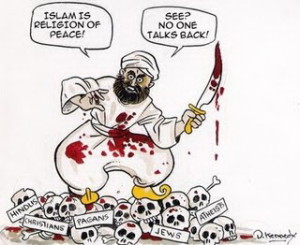By Howard Richman and Raymond Richman
The year was 375. The Roman Empire contained about a fourth of the world’s people stretching across Europe from Brittania in the north to Egypt in the south, from Spain in the west to what is now Bulgaria in the east.
Meanwhile, just east of Bulgaria, the Visigoths (Western Goths), fleeing the depredations of Hun horsemen, wanted to cross the Danube River into the safety of the Roman Empire. The Visigoths were also attracted by the glorious wealth of the Roman Empire.
The story of the refugee crisis is told in the final chapter of Edward Gibbon’s classic The Decline and Fall of the Roman Empire. About 500,000 Goths, men, women and children, lined the bank of the Danube River for miles, seeking to cross:
With outstretched arms and pathetic lamentations they loudly deplored their past misfortunes and their present danger; acknowledged that their only hope of safety was in the clemency of the Roman government; and most solemnly protested that, if the gracious liberality of the emperor would permit them to cultivate the waste lands of Thrace, they should ever hold themselves bound, by the strongest obligations of duty and gratitude, to obey the laws and to guard the limits of the republic.
The Goths tried to force the mile-wide Danube, but failed and were driven back by Roman soldiers. Many Goths drowned. Perhaps a pathetic child’s body washed ashore. The callous brutality outraged Roman opinion. The Roman soldiers who had fought off the Goths were condemned. Gibbon writes:
[T]he brave officers who had served their country in their execution of their duty were punished by the loss of their employments, and narrowly escaped the loss of their heads.

Valens was having trouble filling the ranks of his army. He hoped that the Goths could provide the needed conscripts. Then the Roman provinces, instead of conscripts, could provide gold and he could win his next war with the Persians. His ministers praised Valens’ fortune. Gibbon writes:
[T]hey applauded the liberality of fortune which had conducted, from the most distant countries of the globe, a numerous and invincible army of strangers to defend the throne of Valens, who might now add to the royal treasures the immense sums of gold supplied by the provincials to compensate their annual proportion of recruits.
Valens temporarily settled the Goths in refugee camps, where they were mistreated and starved. Gibbon describes the Goths as an aggressive people who react with “insolence” or “indignation” if they conceive themselves “to be objects either of fear or of contempt.”
If Valens thought that the Goths would be forever grateful to him and Rome, he was mistaken. In 378 they killed Valens at the Battle of Adrianople. In 397 they pillaged Greece. In 410 they sacked Rome, which helped plunge Europe into the chaos of the Dark Ages.
Many Goths settled down to peaceful lives. But a sufficient number engaged in looting and depredations to change Europe forever.
Fast Forward to the Present
As Europe faces swelling waves of migrants, much depends upon the capacity to integrate and merge immigrants into society, a capacity at which the U.S. has performed relatively well, and Europe poorly. Arguably this integration failure reflects the lack of a strong pan-EU cultural identity. If such an identity was to develop, it might be, like U.S. national identity, based upon shared values of constitutional government, democracy, and liberty.
In the absence of such an identity, migrants are almost inevitably left on the outside for generations. If being European means many generations of heritage in the lands of a particular EU nation-state, then no migrant (nor even the migrant’s children) can become European soon enough to avoid alienation, radicalization, and a risk of violence. The fruits of Europe’s difficulty assimilating migrants are readily apparent, and bode poorly.
Although the U.S. has had scattered incidents of terrorism committed by Muslim immigrants, it has not experienced systematic efforts by immigrants to suppress speech and debate through violence and intimidation.

- “As long as the Muslim population remains around or under 2% in any given country, they will be for the most part be regarded as a peace-loving minority, and not as a threat to other citizens.”
- “At 2% to 5%, they begin to proselytize from other ethnic minorities and disaffected groups, often with major recruiting from the jails and among street gangs.”
- “From 5% on … they will work to get the ruling government to allow them to rule themselves (within their ghettos) under Sharia, the Islamic Law.”
- “When Muslims approach 10% of the population, they tend to increase lawlessness as a means of complaint about their conditions.”
- “After reaching 20%, nations can expect hair-trigger rioting, jihad militia formations, sporadic killings, and the burnings of Christian churches and Jewish synagogues.”
- “At 40%, nations experience widespread massacres, chronic terror attacks, and ongoing militia warfare.”

In the U.S., the current Muslim population is about 2%, but with President Obama’s help, it is growing at warp speed. According to Investor’s Business Daily, as of August 20 Rand Paul and Donald Trump were the only two major candidates for president calling for limits on Muslim immigration. On Wednesday, at a campaign rally in Keene, New Hampshire, Trump sharpened his position:
I’m putting the people on notice that are coming here from Syria as part of this mass migration. If I win, they’re going back. They’re going back. I’m telling you. They’re going back.
During the fall of Rome, the Roman people commonly sighed, “Sic transit gloria mundi,” which means: “Thus passes the glory of the world!” Will we soon be sighing about the fall of modern Europe? Does the same fate await the United States?











